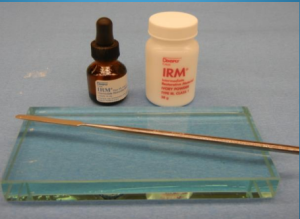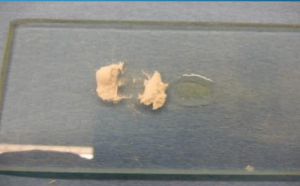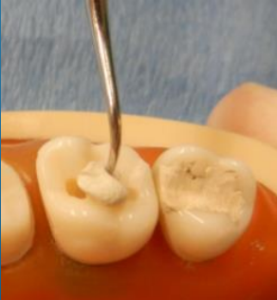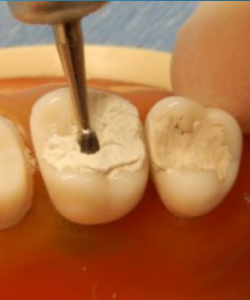When you encounter a dental emergency such as a lost filling or fractured cusp, or if you’re experiencing unresolved discomfort or sensitivity after a filling, your dentist might recommend a temporary tooth filling using Intermediate Restorative Material (IRM). This is also known as a medicated filling for reasons we will go into later in this article. Understanding what IRM is and its benefits can help you feel more at ease with this temporary solution and help you decide if you should get it.
What is IRM?

Intermediate Restorative Material, commonly referred to as IRM or ZOE (Zinc Oxide Eugenol), is a widely used temporary dental filling material in dentistry. It is designed for temporary use, typically lasting up to 10 months. Here’s a breakdown of its components:
- IRM Powder: Contains Zinc oxide and polymethylmethacrylate.
- IRM Liquid: Composed of Eugenol and acetic acid.
Temporary fillings can be used for specific purposes in dental care, including:
- Emergencies: It is ideal for temporary fillings in cases of lost fillings, fractured cusps, or other dental emergencies. IRM fillings are easier to place and take less time, so dentists can place them while they find time in their schedule to place a permanent solution.
- Post-Operative Discomfort: Temporary fillings can be used when there is unresolved discomfort or unexplained sensitivity after dental procedures. This is because of sedative and antibacterial properties within the filling that help heal the tooth.
- Deep Caries Management: When you have a very deep filling it sometimes becomes necessary to complete a filling on two different days. Utilizing a temporary filling in a “2-stage” restoration helps to provide a temporary solution before a more permanent restoration is applied.
- Base Under Amalgam Fillings: IRM may also be used as a base under amalgam fillings to provide additional support.
Benefits and Disadvantages of IRM
IRM offers several advantages as a temporary filling material:
- Palliative Effect: The material contains eugenol, a substance that has a sedative effect on the dental pulp, providing relief from pain.
- Antibacterial Properties: It helps in reducing bacteria in the affected area.
- Excellent Seal: IRM provides a good seal with the existing tooth structure. This helps in protecting the tooth from further decay or infection.
- Easy Removal: When it’s time for a permanent restoration, IRM can be easily removed without causing additional discomfort.
While IRM is beneficial, there are important considerations to keep in mind:
- Eugenol Content: Eugenol in IRM is cytotoxic, which means it can be irritating if placed too close to the dental pulp. To prevent irritation, dentists often use a layer of calcium hydroxide (Ca(OH)2) before applying IRM.
- Not Suitable for Composite Resins: IRM should not be used under composite resin fillings, as eugenol can interfere with the chemical and physical properties of the composite materials.
Procedure Steps for Receiving a Temporary Tooth Filling
If your dentist decides to use IRM for your temporary filling, here’s what you can expect during the procedure:
Preparation:

The dentist will clean the affected tooth and surrounding area to remove any debris or remaining decay.
Isolation:

The tooth will be isolated using a dental dam or cotton rolls to keep it dry during the procedure.
Mixing the IRM:

The IRM powder and liquid will be mixed to create a thick, putty-like consistency.
Application:

The mixed IRM is carefully placed into the cavity or damaged area of the tooth using a dental instrument.
Shaping:

The dentist will shape the IRM to fit the tooth’s contours and ensure it does not interfere with your bite.
Setting:

The material will be allowed to set, forming a hard, protective barrier over the damaged area.
Final Adjustments:
Once set, the dentist may make final adjustments to ensure the filling is smooth and comfortable.
Conclusion
Temporary tooth fillings using IRM are a practical and effective solution for various dental issues, providing relief and protection until a permanent restoration can be placed. If you experience a dental emergency or post-operative discomfort, consult with your dentist about the possibility of using IRM as a temporary measure. Understanding its uses, benefits, and limitations can help you make informed decisions about your dental care.
Disclaimer
The contents of this website, such as text, graphics, images, and other material are for informational purposes only and are not intended to be substituted for professional medical advice, diagnosis, or treatment. Nothing on this website constitutes the practice of medicine, law or any other regulated profession.
No two mouths are the same, and each oral situation is unique. As such, it isn’t possible to give comprehensive advice or diagnose oral conditions based on articles alone. The best way to ensure you’re getting the best dental care possible is to visit a dentist in person for an examination and consultation.
SAVE TIME AND MONEY AT ANY DENTIST

Less dental work is healthier for you. Learn what you can do to minimize the cost of dental procedures and avoid the dentist altogether!

